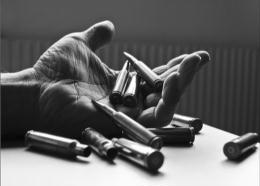

 The Accurate Reloading Forums
The Accurate Reloading Forums  THE ACCURATE RELOADING.COM FORUMS
THE ACCURATE RELOADING.COM FORUMS  Rifles
Rifles  Small Calibers
Small Calibers  big game bullets in small calibers
big game bullets in small calibersGo  | New  | Find  | Notify  | Tools  | Reply  |  |
| one of us |
1894 in the small game forum said something very true, but I am still undecided. "you do not need a Barnes X to penetrate a roe deer" That was refeered to a 6PPC, but I'm wondering, in a .243 how would they go on pigs? or maybe fallow deer? or long shots on chamois? does anyone here have any experience with these bullets on small game? I like the idea of a bullet that will definately expand, even though little, then exit, or allow for devistating bone shots(I like break a shoulder when trophy hunting, it keeps them down or close by) then continue to exit after having opened those nasty little "petals" | ||
|
| one of us |
The 243 is certainly not a round that has characteristics such as "bone smashing" often hung on its shoulders, still it can do for all the game you listed. The biggest challenge for the 243 will be on the pigs. If you hunt small to medium pigs and sows, the 243 will do great. If you hunt the big boars with their heavy grissel shield and expect to bust a shoulder and still get full penetration your asking alot from a little guy. Best bullet I feel for heavy pigs would be the 100 gr partition. I would try to stay away from the shoulders of any boar that over 300 pounds with the 243. Slip one behind the front leg and he won't go far at all. For all the other game you mentioned, I feel any of the conventional bullets from speer, sierra, nosler and hornady in weights from 85 to 100 gr would work great on these lighter targets. Hope this helps!!! Good Hunting!! 50 | |||
|
| one of us |
Express: Regardless of the caliber or bullet performance, I think that most hunters are burdened with the same myth: That a broken shoulder will somehow "anchor" game. Game animals have four good legs, and the loss of the use just one of them, especially a front one, doesn't slow them appreciable in their retreat (or charge, for that matter). I've seen whitetails run rapidly for hundreds of yard with shoulders that were not just broken, but actually "dangling" and virtually detached from the body. What is important is not the shoulder itself, but the vital organs which may, depending on the angle of the shot, lie directly behind the shoulder. If you need to go through the shoulder to get to the heart or lungs, then breaking or disabling the shoulder is simply a dividend of properly shooting into the vitals. If, on the other hand, the game is quartering away in such manner that a shot to the vitals will miss both the near and far shoulders, then shoot for the vitals; even though the shoulder is not hit, the animal will likely be recovered a similar distance from where it was shot. Damaging the shoulder is insignificant in terms of stopping game compared to adequately traumatising the heart or lungs. | |||
|
| new member |
Well said, Stonecreek. Perfect. | |||
|
| one of us |
I wholeheartedly agree with my fellow poster Stonecreek but would just add that BOTH shoulders broken does normaly result in collapse. Also breaking a shoulder on the way to the vitals does generaly mean good expansion of a well chosen bullet not to mention some secondary fragments. Barnes do a 115gr RN original that according to shihlen should stabilise in a standard 243 barrel - now that starts to elevate the 6mm to the revered 256mannlicher levels of SD! | |||
|
| one of us |
My favorite bullet in .243 is the 100gr Hornady boattail, I've shot Crows to Whitetails with it, and the performance has been excellent. As for the hit them in the shoulder shot's, I've found that my .270 with a 150gr Nosler, can Easily disintigrate both shoulders! | |||
|
| one of us |
EXPRESS, I have a good exemple for an EU caliber. 6.5X68 a 120 gr bullet at 3182 fps. We can call this caliber "Small Magnum Caliber". Suitable to take big animals but not too big ------------------ | |||
|
| Powered by Social Strata |
| Please Wait. Your request is being processed... |
|
 The Accurate Reloading Forums
The Accurate Reloading Forums  THE ACCURATE RELOADING.COM FORUMS
THE ACCURATE RELOADING.COM FORUMS  Rifles
Rifles  Small Calibers
Small Calibers  big game bullets in small calibers
big game bullets in small calibers

Visit our on-line store for AR Memorabilia

